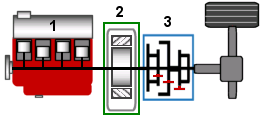The 48 Volt system is a mild hybrid system introduced to give the benefits of a high voltage system without the additional health and safety concerns of such systems which operate at high voltage. The safety cut-off voltage for special considerations and precautions, such as contact protection and insulation control is in excess of 60 Volts. It is supplementary to the standard 12 volt system that is universally used. Some manufacturers favor vehicles fitted with an Integrated Starter Generator (ISG), which can assist the internal combustion engine during acceleration and high loads. The ISG is located between the internal combustion engine and the transmission. Many manufacturers use an electric supercharger also to increase engine power output even further. The ISG can harvest kinetic energy under over-run conditions to charge the high voltage Lithium ion battery.
The ISG is a brushless DC motor that requires position sensors on all three phases for correct commutation.


1) Internal Combustion Engine.
2) Integrated Starter Generator.
3) Transmission.
The engine water pump and air conditioning compressor can be operated via the 48V system, this allows for seamless transition within the cabin when the stop/start system is activated. This also makes the engine drive-belt redundant, further increasing the efficiency of the engine by reducing losses.
Other manufacturers have implemented a belt-driven starter/alternator which can be classified as a synchronous machine similar to a conventional alternator or an asynchronous inductance machine. The drive of this system can limit maximum torque output.
1) Internal Combustion engine.
2) Belt Drive Starter Generator.
3) Clutch.
4) Transmission.
A DC to DC converter is required to "step-down" the voltage from 48V for the 12V system.
Cold start from 12V system:


A) Electrical load.
B) Integrated Starter Generator.
Under extreme cold weather conditions, the Lithium Ion battery performance may be below optimum efficiency. During such conditions the conventional vehicle battery provides power to the DC to Dc converter, this acts as a step-up transformer for the high voltage system and is used to power the ISG. This is illustrated in the diagram above. Note the reduction in current flow as the voltage is increased.
This advancement in vehicle technology reduces CO2 emissions and increases fuel efficiency, comfort, and performance.